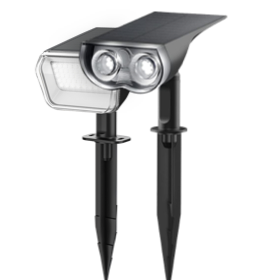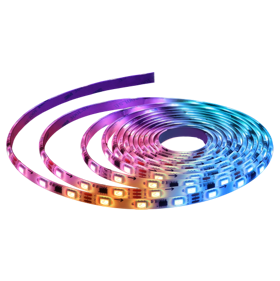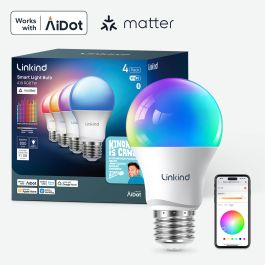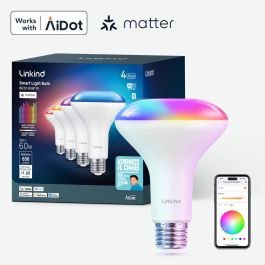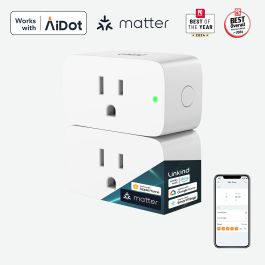The Future of Lighting: Exploring Energy-Efficient Matter Light Bulbs
The Future of Lighting: Exploring Energy-Efficient Matter Light Bulbs
Imagine a world where lighting not only brightens up our spaces but also contributes to a more sustainable future. Energy-efficient matter light bulbs are the key to unlocking this vision. With their revolutionary features and cutting-edge technology, these bulbs are transforming the way we illuminate our lives. Join us on a journey to explore the future of lighting as we delve into the world of energy-efficient matter light bulbs and uncover their countless benefits.

Introduction
1. The significance of energy efficiency in lighting
In an era of rising energy demands and environmental concerns, energy efficiency has become paramount. Lighting alone accounts for a significant portion of global energy consumption. By embracing energy-efficient solutions, we not only reduce our carbon footprint but also save on electricity bills. Energy-efficient matter light bulbs offer a sustainable and cost-effective alternative to traditional lighting options.
2. An overview of Matter light bulbs and their revolutionary features
Matter light bulbs represent the next generation of lighting technology. They are designed to seamlessly integrate with smart home systems, providing users with enhanced control and convenience. These bulbs offer customizable illumination options, dimming capabilities, and voice control features. With their revolutionary functions, Matter light bulbs are revolutionizing the way we experience lighting in our homes and workplaces.
The Science Behind Energy Efficiency in Light Bulbs
1. Understanding energy efficiency and its impact on sustainability
Energy efficiency refers to the ability of a light bulb to convert electrical energy into visible light while minimizing energy waste as heat. This concept is crucial for creating a sustainable lighting ecosystem. By reducing energy consumption, we can mitigate the strain on power resources and decrease greenhouse gas emissions. Energy-efficient light bulbs play a vital role in achieving these goals.
2. Key factors influencing the energy efficiency of light bulbs
Several factors influence the energy efficiency of light bulbs. These include the bulb's efficacy, which measures the amount of light produced per watt of electricity consumed. The bulb's design, such as the use of advanced materials and efficient circuitry, also plays a significant role. Understanding these factors empowers consumers to make informed choices when selecting energy-efficient matter light bulbs.
Benefits of Energy-Efficient Matter Light Bulbs
1. Reducing energy consumption and saving on electricity bills
One of the primary benefits of energy-efficient matter light bulbs is their ability to reduce energy consumption. These bulbs consume significantly less electricity compared to traditional incandescent bulbs while providing the same or even better illumination. By switching to energy-efficient options, individuals and businesses can witness substantial reductions in their electricity bills.
2. Prolonging bulb lifespan and reducing maintenance costs
Energy-efficient matter light bulbs boast impressive longevity. They have significantly longer lifespans compared to traditional bulbs, which means less frequent replacements and reduced maintenance costs. This benefit is particularly advantageous in commercial settings where large-scale lighting systems require extensive upkeep.
3. Environmental advantages and reducing the carbon footprint
The environmental benefits of energy-efficient matter light bulbs cannot be overstated. By reducing energy consumption, these bulbs contribute to lower greenhouse gas emissions and help combat climate change. Additionally, matter light bulbs are designed to be eco-friendly, containing fewer harmful materials and ensuring safe disposal.

Unveiling the Power of Matter Technology in Lighting
1. Exploring the concept of Matter and its role in smart home integration
At the core of energy-efficient matter light bulbs lies the concept of Matter technology. Matter is a universal standard that enables smart devices to seamlessly communicate with one another, regardless of the brand. This technology streamlines the integration of matter light bulbs into smart home ecosystems, promoting interoperability and simplifying the user experience.
2. How Matter light bulbs enhance connectivity and interoperability
Matter light bulbs are designed to work harmoniously with a wide range of smart home devices. Whether it's connecting with voice assistants, smart hubs, or other matter-compatible devices, these bulbs offer unparalleled connectivity options. The seamless integration ensures a cohesive and user-friendly smart home experience, where lighting becomes an integral part of a connected lifestyle.
Features and Functions of Energy-Efficient Matter Light Bulbs
1. Customizable illumination options for personalized lighting experiences
Matter light bulbs provide users with the ability to customize their lighting experiences. With adjustable color temperatures and brightness levels, individuals can create the perfect ambiance for any occasion. Whether it's a warm, cozy glow for relaxation or a vibrant, energizing light for productivity, matter light bulbs offer a personalized touch to suit every preference.
2. Dimming capabilities and creating the perfect ambiance
Dimming capabilities are a sought-after feature in modern lighting solutions. Matter light bulbs excel in this aspect, allowing users to effortlessly adjust the brightness according to their needs. From creating a romantic atmosphere to setting the mood for movie nights, matter light bulbs offer versatile dimming options that cater to diverse lighting requirements.
3. Voice control and seamless integration with smart home systems
The convenience of voice control cannot be underestimated. Matter light bulbs can be seamlessly integrated with voice assistants, enabling users to control their lighting through simple voice commands. Whether it's turning the lights on/off, adjusting brightness, or changing colors, voice control offers a hands-free and intuitive way to interact with matter light bulbs.
Choosing the Right Energy-Efficient Matter Light Bulbs
1. Factors to consider when selecting Matter light bulbs for your space
When selecting energy-efficient matter light bulbs, it's essential to assess your specific needs and preferences. Here are some key factors to consider:
Lumen Output: refers to the brightness level of the bulb. Higher lumen values indicate brighter light output, while lower values indicate a softer glow. Consider the desired brightness for your space and choose matter light bulbs with appropriate lumen ratings accordingly.
Color Temperature: is measured in Kelvin and determines the warmth or coolness of the light emitted by the bulb. It plays a crucial role in setting the mood and ambiance of a room. Lower Kelvin values (around 2700K to 3000K) produce warm, cozy light, while higher values (around 5000K to 6500K) create a cool, daylight-like atmosphere. Consider the desired atmosphere and choose matter light bulbs with the appropriate color temperature.
Compatibility with Smart Home Systems: If you have an existing smart home ecosystem, ensure that the matter light bulbs you choose are compatible with your system. Compatibility allows for seamless integration and control of your lighting through smart home platforms and voice assistants.
Bulb Type: Matter light bulbs come in various types, such as A19 and BR30, each designed for specific applications and fixtures. A19 bulbs are the standard bulb shape and are suitable for most fixtures, including table lamps, floor lamps, and pendant lights. BR30 bulbs, on the other hand, have a wider beam angle and are often used in recessed lighting fixtures. Consider the type of fixtures you have in your space and choose matter light bulbs accordingly.
2. Understanding lumens, color temperature, and different bulb types
To make an even more informed decision, let's dive deeper into lumens, color temperature, and different bulb types.
Lumens: measure the total amount of visible light emitted by a bulb. The higher the lumen value, the brighter the light output. When choosing matter light bulbs, consider the desired level of brightness for your space. For example, a matter light bulb with 800 lumens is suitable for accent lighting or smaller rooms, while a bulb with 1600 lumens is better suited for larger areas or areas that require brighter illumination.
Color Temperature: refers to the appearance of light produced by a bulb, ranging from warm to cool tones. The color temperature is measured in Kelvin (K). Lower Kelvin values, such as 2700K to 3000K, produce warm, yellowish light, resembling the glow of traditional incandescent bulbs. Higher Kelvin values, such as 5000K to 6500K, emit cooler, bluish-white light, resembling daylight. Consider the mood and atmosphere you want to create in your space when choosing the color temperature of your matter light bulbs.
Different Bulb Types: Matter light bulbs are available in different types, including A19 and BR30. A19 bulbs are the most common and versatile bulb type. They have a standard bulb shape and fit most fixtures. A19 bulbs are suitable for table lamps, floor lamps, ceiling fixtures, and other general lighting applications. BR30 bulbs have a reflector shape and are primarily used in recessed lighting fixtures. The BR stands for "bulged reflector," indicating the bulb's wider beam angle. BR30 bulbs are commonly used in kitchens, living rooms, and other areas where focused or directional lighting is desired.
3. Starting with Linkind A19 Matter Light bulbs
One recommended option for energy-efficient matter light bulbs is the Linkind A19 Matter Light bulbs. These bulbs combine energy efficiency, advanced technology, and user-friendly features to provide an excellent lighting experience.
Moreover, Linkind A19 Matter Light bulbs are designed to seamlessly integrate with various smart home systems, allowing you to control your lighting through voice commands or smartphone apps. This compatibility ensures a convenient and interconnected smart home experience.
By starting with Linkind A19 Matter Light bulbs, you can enhance your space with energy-efficient lighting that meets your brightness, color, and smart home integration needs.
In conclusion, choosing the right energy-efficient matter light bulbs involves considering factors such as lumen output, color temperature, compatibility with smart home systems, and bulb types.

Installing and Setting Up Energy-Efficient Matter Light Bulbs
1. Step-by-step guide to installing Matter light bulbs
Installing matter light bulbs is a straightforward process. Begin by turning off the power, then remove the existing bulb and insert the matter light bulb into the socket. Ensure a secure fit, and then switch the power back on. It's essential to follow the manufacturer's instructions for specific installation steps and safety precautions.
2. Pairing and integrating Matter light bulbs with your smart home ecosystem
To enjoy the full range of features, matter light bulbs need to be paired and integrated with your smart home ecosystem. This typically involves downloading the relevant app, creating an account, and following the instructions to connect the bulbs to your home network. Once successfully paired, you can control the bulbs remotely and integrate them into your existing smart home routines and automation.
Maximizing Energy Savings with Matter Light Bulbs
1. Proven tips and tricks for optimizing energy efficiency
While matter light bulbs are inherently energy-efficient, there are additional measures you can take to maximize their energy-saving potential. These include utilizing daylight sensors or motion detectors to ensure lights are only active when needed, grouping bulbs into zones for more precise control, and scheduling lighting to align with your daily routines. By leveraging these tips and tricks, you can further enhance the energy efficiency of matter light bulbs.
2. Leveraging scheduling and automation features for efficient lighting
Matter light bulbs offer scheduling and automation features that allow for effortless energy management. You can create custom schedules to turn lights on/off at specific times or set them to respond to external triggers, such as sunrise/sunset. Additionally, integrating matter light bulbs with other smart devices, such as occupancy sensors, enables automated lighting control based on occupancy, further optimizing energy efficiency.
Comparing Energy-Efficient Matter Light Bulbs with Traditional Options
1. Advantages of Matter light bulbs over traditional lighting solutions
When compared to traditional lighting solutions like incandescent or fluorescent bulbs, matter light bulbs have numerous advantages. They are significantly more energy-efficient, consume less power, and last much longer. Matter light bulbs also offer greater versatility in terms of customization, connectivity, and smart home integration, enhancing the overall lighting experience.
2. Cost-effectiveness and long-term savings with Matter technology
Although matter light bulbs may have a slightly higher upfront cost compared to traditional bulbs, their long-term savings are undeniable. With their energy efficiency and extended lifespan, matter light bulbs result in substantial reductions in electricity bills and maintenance expenses. Over time, the cost-effectiveness of matter technology becomes apparent, making it a wise investment for both residential and commercial applications.

Environmental Impact of Energy-Efficient Matter Light Bulbs
1. Evaluating the eco-friendly aspects and sustainability benefits
Energy-efficient matter light bulbs have significant environmental advantages. By consuming less electricity, they contribute to reduced carbon emissions, helping combat climate change. Furthermore, matter light bulbs are designed to be more eco-friendly, with lower levels of hazardous materials. This eco-conscious approach ensures safer disposal and minimizes the environmental impact throughout the lifecycle of the bulbs.
2. Analyzing the environmental impact of Matter light bulbs
Matter light bulbs excel in terms of environmental impact compared to traditional options. Their energy efficiency reduces the strain on power resources, decreases reliance on fossil fuels, and minimizes the generation of greenhouse gases. Additionally, matter light bulbs have a longer lifespan, reducing the frequency of bulb replacements and the associated waste. By adopting matter technology, individuals and businesses can actively contribute to a greener future.
Maintenance and Care for Energy-Efficient Matter Light Bulbs
1. Proper handling, cleaning, and maintenance practices for longevity
To ensure the longevity of energy-efficient matter light bulbs, proper handling, cleaning, and maintenance practices are essential. It is recommended to handle bulbs with care, avoiding excessive force or impacts. Cleaning should be done with a soft, dry cloth to remove dust and debris. Regular maintenance, such as checking for loose connections and updating firmware, helps optimize performance and prolong the lifespan of matter light bulbs.
2. Troubleshooting common issues and ensuring optimal performance
Occasionally, matter light bulbs may encounter common issues that can affect performance. These include connectivity problems, firmware updates, or compatibility issues with other devices. Troubleshooting these issues often involves following manufacturer guidelines, ensuring firmware is up to date, and troubleshooting connectivity through appropriate channels. By addressing these concerns promptly, users can maintain optimal performance from their energy-efficient matter light bulbs.
The Future of Energy-Efficient Lighting: Innovations on the Horizon
1. Exploring emerging trends in energy-efficient lighting technology
The future of energy-efficient lighting holds exciting possibilities. Emerging trends include advancements in smart controls, improved connectivity options, and enhanced energy management features. Innovations such as adaptive lighting, circadian rhythm synchronization, and gesture control are set to revolutionize the way we interact with light and further improve energy efficiency.
2. Predicting advancements and possibilities for Matter light bulbs
Matter light bulbs are poised to evolve and adapt to future technological advancements. As the Matter standard gains wider adoption, the compatibility and interoperability of matter light bulbs with other smart devices will expand. The integration of artificial intelligence and machine learning algorithms may further optimize energy efficiency and enable personalized lighting experiences. With continuous innovation, matter light bulbs are at the forefront of the future of energy-efficient lighting.

Summary and Conclusion
1. Recapitulating the benefits of energy-efficient Matter light bulbs
Energy-efficient matter light bulbs offer numerous benefits, including reduced energy consumption, cost savings, and environmental advantages. They provide customizable illumination options, seamless integration with smart home systems, and extended lifespans. Matter light bulbs are paving the way for a more sustainable and connected future.
2. Encouraging widespread adoption of sustainable lighting solutions
The adoption of energy-efficient matter light bulbs is a step towards a more sustainable future. By embracing these innovative lighting solutions, individuals and businesses can contribute to reducing energy consumption, saving costs, and mitigating environmental impact. It's time to illuminate our lives with energy efficiency and embrace the future of lighting through matter light bulbs.
FAQs: Common Questions about Energy-Efficient Matter Light Bulbs
1. What makes Matter light bulbs energy-efficient?
Matter light bulbs are energy-efficient due to their advanced technology and design, which maximize the conversion of electrical energy into visible light while minimizing energy waste as heat.
2. Are Matter light bulbs compatible with existing smart home systems?
Yes, Matter light bulbs are designed to be compatible with existing smart home systems. They seamlessly integrate with other matter-compatible devices, offering enhanced connectivity and interoperability.
3. How do energy-efficient light bulbs help reduce electricity bills?
Energy-efficient light bulbs consume less electricity while providing the same or better illumination, resulting in reduced energy consumption and lower electricity bills.
4. Can I dim Matter light bulbs to create different lighting moods?
Yes, matter light bulbs often come with dimming capabilities, allowing users to adjust the brightness and create different lighting moods to suit their preferences.
5. Are there any health concerns associated with energy-efficient lighting?
Energy-efficient lighting, including matter light bulbs, adheres to health and safety standards. They do not emit harmful levels of ultraviolet (UV) or infrared (IR) radiation, making them safe for everyday use.
6. What are the environmental benefits of using Matter light bulbs?
Using matter light bulbs contributes to reduced energy consumption, lower carbon emissions, and a smaller environmental footprint. They are designed to be more eco-friendly, with minimal hazardous materials and a longer lifespan.
7. Are there any limitations or drawbacks to using Matter light bulbs?
While matter light bulbs offer numerous advantages, some limitations may include higher upfront costs compared to traditional bulbs and the need for a compatible smart home ecosystem for full functionality. However, the long-term energy savings and enhanced lighting experience outweigh these considerations.












